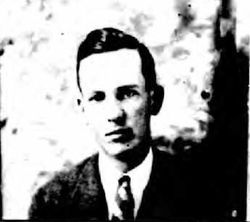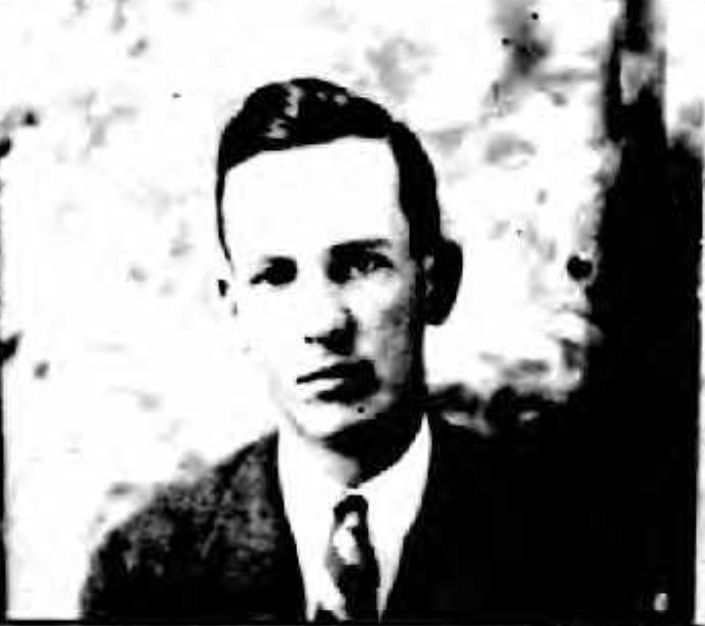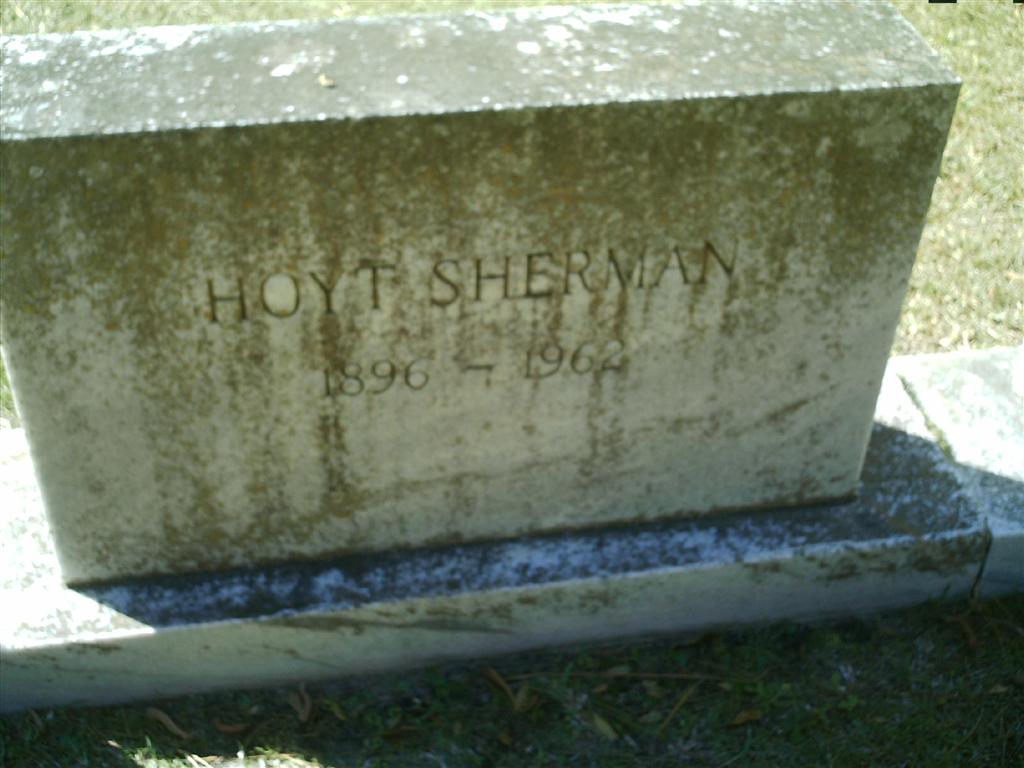Sherman was an officer in World War I in the famed Harlem Hellfighters. Post-war he moved to Venezuela and was a pioneer in the nation's growth in the gas and petroleum industries. He was the scion of a famous pioneer family who helped found Des Moines, Iowa. His namesake grandfather, Hoyt Sherman, worked for Abraham Lincoln and Gen. Ulysses S. Grant in the Civil War as U.S. Army paymaster. His grandfather was the younger brother of judge John Sherman, the writer of the Sherman Anti-Trust Act, and Civil War General William Tecumseh Sherman. His first cousin was Sara Sherman Wiborg Murphy, Jazz Age icon and close friend with F. Scott Fitzgerald.
Hoyt was born Charles Hoyt Sherman on 6 September 1896 in Chicago to Charles M. Sherman, an attorney, and Bertha Bartlett Sherman, descendant of Josiah Bartlett, a signer of the Declaration of Independence.
He attended local schools, traveled to Europe as a boy, and was accepted to Harvard. He interrupted his studies and took a leave of absence to train with the U.S. Army after the U.S. entered the Great War. Sherman entered officers' training camp in Plattsburg, New York, in August 1917. He trained with scores of Ivy League students and businessmen to receive military instruction. He was commissioned a second lieutenant in November and sailed for France on 4 January 1918. Sherman was put into Specialists' School in Langres.
In France he was assigned to lead Company C, 369th Infantry Regiment, formerly the 15th New York, in March 1918. This was the vaunted Harlem Hellfighters, the nearly all-black regiment. As the Army was segregated in that era, the majority of the officers were white. Sherman was a lieutenant. He also served as regimental intelligence officer. After three weeks' training by French troops, the 369th entered the combat trenches on April 15, 1918 – more than a month before the American Expeditionary Forces' first major battle.
Sherman and his men were attached to French divisions, who did not have racial bias like the American Army. The 369th saw heavy combat and the engagements he fought in were among the bloodiest of the war: Champagne-Marne defensive, Vienne-la-Ville sector, Marne-Aisne and Meuse-Argonne offensive. Sherman was promoted to first lieutenant in the field on September 20; six days later he was wounded. The Republic of France awarded him the Croix de Guerre with silver star for bravery. His citation reads:
"A toujours fait preuve du plus grand courage et d'esprit de sacrifice dans l'exécution de ses missions. Le 26 Septembre 1918, a été projeté par l'explosion d'un obus de gros calibre qui tua deux hommes à ses côtés et lui occasion une grave commotion."
"Has always shown the greatest courage and spirit of sacrifice in the execution of his missions. On September 26, 1918, was projected by the explosion of a large caliber shell which killed two men at his side and caused him a serious concussion."
Following his recuperation from his wounds, Sherman returned to New York in December. He was detailed to be an instructor at Camp Meade, Maryland, until his discharge in August 1919. He then completed his A.B. degree at Harvard.
In October 1922 in Jamestown, Rhode Island, he wed Katherine Floyd-Jones, a St. Louis native, in a small family ceremony. They promptly left the country for Mexico and his new job.
In 1921 he entered the field of oil refinement and began a career that took him to far-flung oil fields. He joined the France & Canada Oil Transport Company in 1921 and was sent to Mexico as an engineer. He represented the New England Oil Refining Company of Boston (later acquired by Standard Oil Co.) in Tampico, Mexico, rising to general manager. In 1926 he began more than 30 years of residence in Caracas, Venezuela, with the Mene Grande Oil Company (100 percent of the shares were owned by Gulf). He started as an engineer and opened up new fields of exploration. He rose to president of the company, retiring in 1956. Before he returned to the U.S., the Venezuelan government decorated him with the order of Francisco de Miranda.
The couple had three children: Mary, born 1926 in Newport, Rhode Island; Katherine, born 1932 in Newport; and John, born 1934 in Venezuela.
He and his wife also kept a home in Winter Park, Florida. They resided there from 1956-1962. Hoyt Sherman died 15 October 1962 in Orange, Florida. He was 66 years old.
Sherman was an officer in World War I in the famed Harlem Hellfighters. Post-war he moved to Venezuela and was a pioneer in the nation's growth in the gas and petroleum industries. He was the scion of a famous pioneer family who helped found Des Moines, Iowa. His namesake grandfather, Hoyt Sherman, worked for Abraham Lincoln and Gen. Ulysses S. Grant in the Civil War as U.S. Army paymaster. His grandfather was the younger brother of judge John Sherman, the writer of the Sherman Anti-Trust Act, and Civil War General William Tecumseh Sherman. His first cousin was Sara Sherman Wiborg Murphy, Jazz Age icon and close friend with F. Scott Fitzgerald.
Hoyt was born Charles Hoyt Sherman on 6 September 1896 in Chicago to Charles M. Sherman, an attorney, and Bertha Bartlett Sherman, descendant of Josiah Bartlett, a signer of the Declaration of Independence.
He attended local schools, traveled to Europe as a boy, and was accepted to Harvard. He interrupted his studies and took a leave of absence to train with the U.S. Army after the U.S. entered the Great War. Sherman entered officers' training camp in Plattsburg, New York, in August 1917. He trained with scores of Ivy League students and businessmen to receive military instruction. He was commissioned a second lieutenant in November and sailed for France on 4 January 1918. Sherman was put into Specialists' School in Langres.
In France he was assigned to lead Company C, 369th Infantry Regiment, formerly the 15th New York, in March 1918. This was the vaunted Harlem Hellfighters, the nearly all-black regiment. As the Army was segregated in that era, the majority of the officers were white. Sherman was a lieutenant. He also served as regimental intelligence officer. After three weeks' training by French troops, the 369th entered the combat trenches on April 15, 1918 – more than a month before the American Expeditionary Forces' first major battle.
Sherman and his men were attached to French divisions, who did not have racial bias like the American Army. The 369th saw heavy combat and the engagements he fought in were among the bloodiest of the war: Champagne-Marne defensive, Vienne-la-Ville sector, Marne-Aisne and Meuse-Argonne offensive. Sherman was promoted to first lieutenant in the field on September 20; six days later he was wounded. The Republic of France awarded him the Croix de Guerre with silver star for bravery. His citation reads:
"A toujours fait preuve du plus grand courage et d'esprit de sacrifice dans l'exécution de ses missions. Le 26 Septembre 1918, a été projeté par l'explosion d'un obus de gros calibre qui tua deux hommes à ses côtés et lui occasion une grave commotion."
"Has always shown the greatest courage and spirit of sacrifice in the execution of his missions. On September 26, 1918, was projected by the explosion of a large caliber shell which killed two men at his side and caused him a serious concussion."
Following his recuperation from his wounds, Sherman returned to New York in December. He was detailed to be an instructor at Camp Meade, Maryland, until his discharge in August 1919. He then completed his A.B. degree at Harvard.
In October 1922 in Jamestown, Rhode Island, he wed Katherine Floyd-Jones, a St. Louis native, in a small family ceremony. They promptly left the country for Mexico and his new job.
In 1921 he entered the field of oil refinement and began a career that took him to far-flung oil fields. He joined the France & Canada Oil Transport Company in 1921 and was sent to Mexico as an engineer. He represented the New England Oil Refining Company of Boston (later acquired by Standard Oil Co.) in Tampico, Mexico, rising to general manager. In 1926 he began more than 30 years of residence in Caracas, Venezuela, with the Mene Grande Oil Company (100 percent of the shares were owned by Gulf). He started as an engineer and opened up new fields of exploration. He rose to president of the company, retiring in 1956. Before he returned to the U.S., the Venezuelan government decorated him with the order of Francisco de Miranda.
The couple had three children: Mary, born 1926 in Newport, Rhode Island; Katherine, born 1932 in Newport; and John, born 1934 in Venezuela.
He and his wife also kept a home in Winter Park, Florida. They resided there from 1956-1962. Hoyt Sherman died 15 October 1962 in Orange, Florida. He was 66 years old.
Family Members
Sponsored by Ancestry
Advertisement
Advertisement












